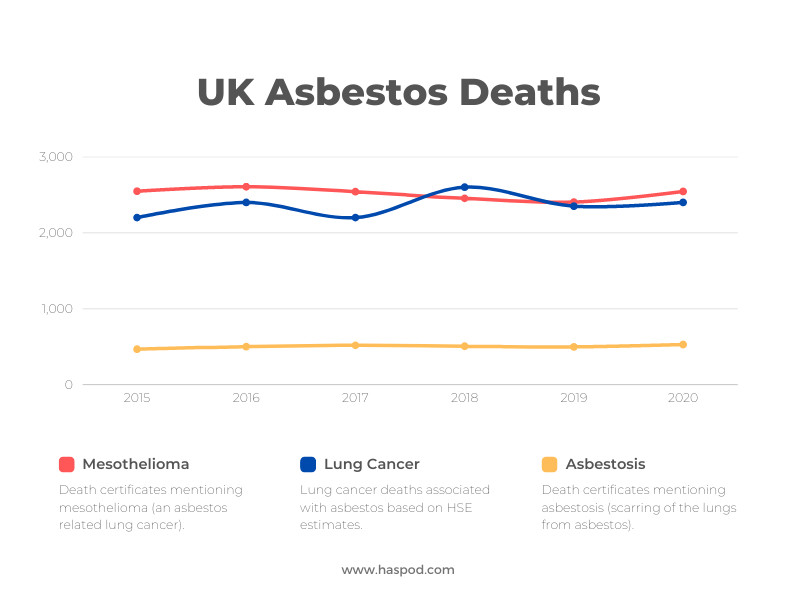7th December, 2022
Asbestos Symptoms And Related Diseases
Asbestos symptoms and related diseases usually don't develop for years - often decades. So it's difficult to pinpoint when the exposure happened. Or know when that troublesome cough is something much more sinister. Asbestos-related diseases kill around 5000 people each year in the UK.

It can take many years - or even decades - for asbestos symptoms and related diseases to develop. Due to this delay from exposure to illness, it is often difficult to pinpoint when you got exposed. Especially because you can't see or identify asbestos without lab testing.
So what are asbestos-related diseases? And how can you know when a troublesome cough is something much more sinister?
Asbestos-related deaths
Asbestos is currently the cause of around 5000 deaths annually. This is a figure that continues to rise, although due to the UK asbestos ban, deaths are expected to start to fall in the following decades.
Asbestos was a popular building product in the UK during the 50s - 70s. It wasn't fully banned until 1999.
Because of its previous popularity, many buildings we live and work in today contain asbestos. In the walls, roofs, guttering, insulation, pipe lagging, doors, panels, cladding... asbestos could be anywhere and everywhere.
If these asbestos materials are disturbed, tiny asbestos fibres that are invisible to the eye are released which can easily be inhaled and enter the lungs. These fibres are sharp and strong. They become hooked inside the lungs and the human body cannot break them down. These asbestos fibres can be debilitating, and can often have fatal consequences.

All types of asbestos are classified as carcinogens. A carcinogen is any substance that is directly involved in causing cancer. Asbestos is well known to be a hazardous and cancer-causing material. Several asbestos-related diseases can develop following exposure. These mostly target the lungs.
Asbestos-Related Lung Diseases
Four lung diseases are (or can be) caused by asbestos exposure.
- Pleural Plaques
- Asbestosis
- Lung Cancer
- Mesothelioma
Asbestos doesn't just cause lung diseases and respiratory problems (although that is the biggest risk). If swallowed, asbestos can also cause cancer in the bowels. Asbestos fibres can irritate the eyes, becoming lodged in the soft tissues.
However, inhalation of asbestos fibres and lung diseases are the biggest risk. As we have already mentioned, asbestos is responsible for a staggering 5,000 deaths in the UK each year.

These deaths are mostly caused by lung cancer and mesothelioma. A few are also caused by asbestosis. Asbestosis can also develop into lung cancer and mesothelioma at later stages.
Pleural Plaques
It all starts with pleural plaques. Well, not necessarily, but this is often one of the first signs of trouble. Asbestos fibres become lodged in lung tissue. Over years, your body reacts and lung tissue thickens around the fibres.
This thickening in the lung lining is a sign that asbestos fibres have become lodged and indicates that more serious asbestos-related diseases may develop.
Asbestosis
As the name suggests, this lung disease is caused by asbestos. Asbestos + osis (meaning disease).
Asbestosis is a scarring of the lungs caused by asbestos fibres. Like pleural plaques, it's a sign that a more serious disease may develop in the future. Not that it is not serious in itself. This lung disease will leave you short of breath, very tired, wheezy and with a nasty cough.
There is no cure for asbestosis, and around 500 deaths are attributed to asbestosis each year in the UK.
Lung Cancer
Around 2,500 people die of asbestos-related lung cancer each year, according to HSE statistics. Cancer develops because of the damage caused by asbestos fibres to the cells of the lungs, and an inflammatory reaction of the body to that damage.
A ratio of one asbestos-related lung cancer for every mesothelioma implies there are currently around 2,500 asbestos-related lung cancer deaths each year.
Mesothelioma
Mesothelioma is probably the most famous asbestos disease and the one you will hear about most often. And not for good reasons. Like asbestosis, this disease is asbestos specific.
Mesothelioma is a type of cancer that develops in the lining of the surface of the lungs. Asbestos fibres are so sharp and small, they can sink deep into lung tissue. Mesothelioma is fatal, and currently responsible for around 2,500 deaths each year in the UK.
There were 2,544 mesothelioma deaths in Great Britain in 2020, a rise of 6% compared with 2019, but similar to the average of 2523 deaths per year over the previous 8 years.
Asbestos Symptoms
There is no cure for any of the asbestos-related diseases we have discussed. That's why preventing asbestos exposure is so important. Here are the common (and unpleasant) symptoms you can develop after asbestos exposure:
- Shortness of breath
- Coughing
- Inflammation
- Areas of scarring
- Restricted breathing
- Sharp stabbing pains on inhaling
- Coughing up blood
- Cough
- Chest pain
- Permanent scarring
- Reduced lung capacity
- Increased risk of lung cancer
- Inhibits normal lung tissue function
- Asbestos-related lung cancer spreading to other organs
Asbestos most affects the lung, so no surprise that these symptoms make breathing difficult and painful.
You won't get these symptoms right away after asbestos exposure. Asbestos-related diseases take years, even decades to develop. Usually, the more asbestos you are exposed to, the more at risk you are, and the quicker the disease develops.

Those most at risk will have been regularly exposed to asbestos as part of their job - for example, people who often disturb existing building materials, like plumbers and electricians.
But you can also develop asbestos-related diseases from a single exposure, especially if you were exposed to a high level of asbestos fibres.
Smokers are also at increased risk. Smoking desensitises the lungs to smoke and particles, and the immune system reduces the white blood cells sent to clean up the lungs.
While the effects of exposure may develop decades after the initial exposure, they can progress rapidly once they begin to appear.
Avoiding asbestos exposure is the only way to reduce the risks, and this is especially important for those who carry out construction or maintenance work in buildings where asbestos is often present and at risk of being disturbed.
Any building you work in should have the right asbestos survey, and you should check where asbestos is to avoid accidental disturbance.
Get the asbestos awareness toolbox talk, and keep your team aware of this killer dust.
This article was written by Emma at HASpod. Emma has over 10 years experience in health and safety and BSc (Hons) Construction Management. She is NEBOSH qualified and Tech IOSH.
Are You Asbestos Aware?
Take our asbestos awareness elearning course and get your certificate today.
Asbestos Awareness CourseRecent posts like this...

10 Asbestos Awareness Questions And Answers Explained
If you have had, or are about to refresh, your asbestos awareness training, you should be able to answer these 10 asbestos awareness questions. Don't worry if you are not sure about the answers - we explain them in this post to help prepare you for your asbestos awareness training.
Read Post
The Risk Of Asbestos In Artex Ceilings
Many buildings contain artex and other textured coatings on walls and ceilings that may contain asbestos. The biggest risk is not the artex itself, but the potentially deadly fibres contained in it. In this post, we look at when you should be worried, and what the law says about asbestos in artex.
Read Post
The Two Types Of Asbestos Survey (And When You Need Them)
There are two types of asbestos survey, the management asbestos survey, and the refurbishment and demolition asbestos survey. A building may require one type, or both, depending on the use of the building and the work planned.
Read Post